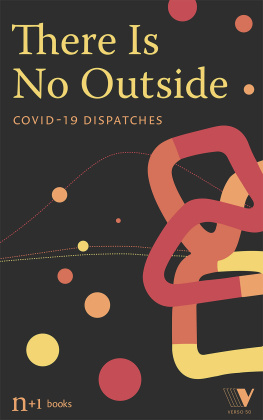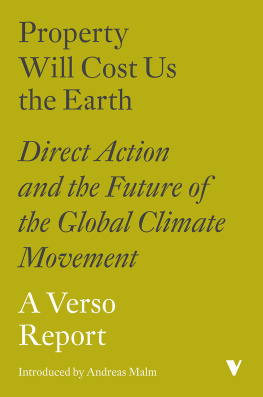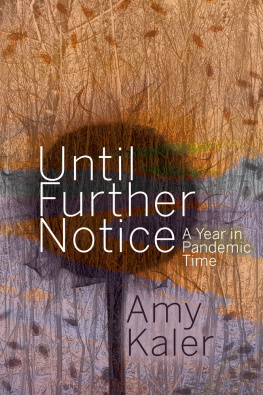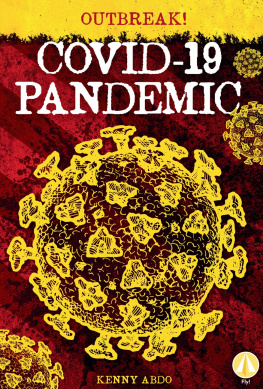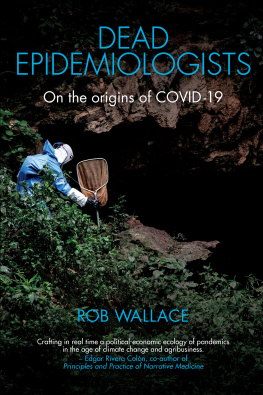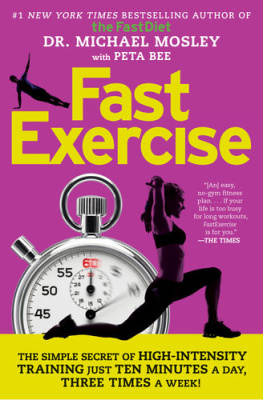Table of Contents
Guide
There Is No Outside
Contents
| Andrew Liu
The best safeguard against the novel coronavirus is the ability to voluntarily withdraw oneself from capitalism
| Rachel Ossip
The virus comes to visit
| Gabriel Winant
What matters now is the balance of authority in everyday lifebetween young and old, worker and boss
| Francesco Pacifico
Rome coronavirus dispatch
| Sarah Resnick
New York State prisons during Covid-19
| Teresa Thornhill
Covid-19 on Lesbos
| Shigraf Zahbi
In less than a week, the virus became the Muslim virus
| Debjani Bhattacharyya and Banu Subramaniam
An ostensible public health tool is being used to create ghettos of the sick
| Mark Krotov
On Michael Sorkin, 19482020
| Karim Sariahmed
Health workers can respond to this crisis by taking up working-class struggles as our own
| Ana Cecilia Alvarez
How can you shelter in place if you do not have shelter?
| Jack Norton
A photo essay from the once and current center of the world
| Laleh Khalili
Sailors face Covid-19
| Aaron Timms
We walk to escape the trauma of the pandemic, only to relive it all over again by walking
| Sonya Aragon
Dont involve the police, I say every time
| Sean Cooper
Roaming through the Covid-19 surveillance state
| Chloe Aridjis
Was she one of the 686 who perished on April 12 or one of the 843 from April 25?
| Marco Roth
Primed for story as we are, we feed our wishes with even meager leavings
There Is No Outside
Covid-19 Dispatches
Edited by
Jessie Kindig
Mark Krotov
Marco Roth

The collection n+1 2020
The contributions The contributors 2020
The photographs Jack Norton 2020
All essays in this collection appeared, or will appear, on the n+1 website at nplusonemag.com; in the print edition of n+1, number thirty-seven; or the Verso Books blog, versobooks.com/blogs, with the exception of Washington County, NY by Jack Norton, which was commissioned for this publication.
Cover design and illustration by Rachel Ossip.
All rights reserved.
The moral rights of the authors have been asserted.
Verso
UK : 6 Meard Street, London, W1F 0EG
US : 20 Jay Street, Suite 1010, Brooklyn, NY 11201
versobooks.com
Verso is the imprint of New Left Books.
ISBN -13, US and Canada: 9781839762307
ISBN -13, UK and Republic of Wales: 9781839762291
There is always outside
Jessie Kindig
The title of this collection is something of a feintthere is always outside.
Even during this quarantine period, from inside our homesshould we have themwe see the outside through windows. From mine, outside looks like birds, masked walkers, ambulances, leafing trees, the NYPD mobile command unit, neighbors arriving to mourn the dead, a small patch of sky. We also try to map the outside world through unemployment rates and death counts, social media posts and hearsay, reports of overwhelmed hospitals and domestic violence hotlines, the spaced-out line of people at the church food bank up the street. Outside glints and beckons. Outside people die.
What these essays track, drawn from n+1s website and print issue and Versos blog over the past weeks, is not the fact of no outside, but rather what it is to feel that there is no outside. Perhaps we work at one of the overwhelmed hospitals, or have been to one. As Karim Sariahmed reports, to experience the ever-worsening status quo of the ER is to know a crisis so severe and all-consuming that there is no outside. The pandemic has only further constricted the thin living space to be had at the extremes of these bordersfor those in prison, on the inside, as Sarah Resnick relates; for the homeless, for whom there is only ever outside, as Ana Cecilia Alvarez notes from Los Angeles; for Muslims in India being further excluded from Hindu society and confined to the insides of ghettos, as Shigraf Zahbi reports from Delhi; and for those, as Teresa Thornhill describes, in Greeces refugee camps, held in limbo between exile and belonging, outside and in.
To be denied an outside is to be forced to mine the interior, to measure the weight of the social body once it has been hollowed out. So Francesco Pacifico recounts from Rome, and so Rachel Ossip describes in her account of the viruss effect on a body. Mark Krotov grieves those who have died, and Chloe Aridjis keeps looking for the ones who have gone missing.
There is, it seems to many of our authors, no outside to outside either. I must leave my house, Sean Cooper declares, yet finds himself entrapped within a Covid-19 landscape of surveillance apps and digitized contact tracing; in a different way, Aaron Timms and Marco Roth each find that the gardens and streets of Brooklyn remind them of the scale of loss that exists and the mammoth work of repair the future will require.
Let me say this. I miss the outside, desperately, by which I mean: I miss the conditions of social life under which we might begin to practice repair. I miss the glinting world.
In quarantine, I have been kept good company by Virginia Woolfs latelastmasterpiece, The Waves. Its a cacophony of a book, full of the mad lyricism of the young eager to eat the whole world, their voices interweaving. Everything, every moment and interaction, every falling leaf and failed kiss and butter-stained napkin means so, so much. Yet the novel is framed by the quiet, human-less beachthe sounds of birds swarming and waves beating and the mute hills, bristlingWoolf sayswith trees. This is a book about what is bundled together and what is kept apart, and the necessary relationship between the two:
In the garden the birds that had sung erratically and spasmodically in the dawn on that tree, on that bush, now sang together in chorus, shrill and sharp; now together, as if conscious of companionship, now alone as if to the pale blue sky Fear was in their song, and apprehension of pain, and joy to be snatched quickly now at this instant.
What makes the world, Woolf reminds, is not the mere fact of it but the waves of relations into which it plunges you. Jack Nortons photo essay from the deindustrialized towns of northern New York reminds us of the same. Everywhere, evenespeciallyspaces gutted by capital, is the center of the universe. Even on an empty beach, the waves still beat.
We are in a moment when outside the crisis and outside the quarantine seems a utopia as unattainable as the diorama in a snow globe. These essays each argue that the global crisis of Covid-19 is intricately connected to the unfolding devastation of neoliberalism and racism, environmental destruction and precarity, mass incarceration and the rise of emboldened authoritarian states. Across India, for example, as Debjani Bhattacharyya and Banu Subramaniam show, the crisis has only served to highlight the spreading virus of Hindu fascism.
Andrew Liu notes in his incisive essay on Wuhan and global capitalism that tracking the spread of the virus illustrates contemporary global interchange at its most prosaic, as the novel coronavirus transmission pathway has followed the circuits of twenty-first century markets.
In so doing, the pandemic has highlighted the vulnerabilities of these nodes, prime among them the precarious workers who exist in the shadow of recognized labor markets. Laleh Khalili surveys the position of seafarers during the epidemic, the workers responsible for global shipping and tourism, without which capitalism in its current form could not function. These sailors, most on short-term contracts with little or no access to health care on board their ships and most from the global south, have been quarantined at sea, adrift and neglected. The pandemic has also left sex workers exposed and adrift. Sonya Aragons personal account reveals how the intimate and proximate labor many sex workers provide is no longer possible during the pandemic, and how criminalization makes any hope of a safety net, unemployment insurance, or health care impossible. Capitalism has made most of us, in Aragons apt phrase, whores at the end of the world.

